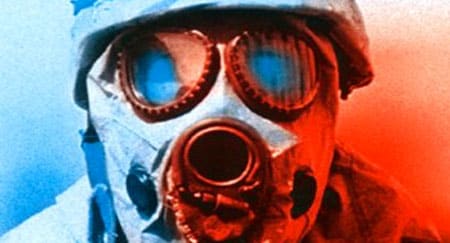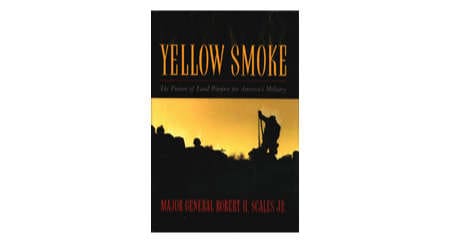James Appathurai reviews two books examining the revolution in military affairs and its impact on the future of warfare.
Ten days into the US-led invasion of Iraq, the first hints of panic were starting to show. Iraqi resistance didn't seem to be collapsing as promised by proponents of the campaign. Supply lines appeared stretched and exposed, without enough troops to guard them as the fighting forces raced ahead. And the battle for Baghdad - where US technological advantages would be dramatically reduced - loomed.
Armchair analysts were quick to offer critiques. The US-led forces were too light, in armour and in number, to ensure victory. The speed of the US advance was dangerous. More seriously still, the critics argued that US Secretary of Defense Donald Rumsfeld and military commander General Tommy Franks were gambling soldiers' lives, and military success, in a reckless test of revolutionary theories of warfare. Indeed, by the third week of the war there were rumblings that Rumsfeld's future and with it his vision of conflict were resting on thin ice in the Iraqi desert.
Within days, however, this prediction was proven spectacularly wrong. The Iraqi military either fled or, where it resisted, was destroyed in short order. Baghdad fell after only a few days, and the Baathist regime was brought to end. The military victory was swift and total, and with remarkably few casualties on all sides.
To casual observers, this success was seen as largely the result of the weakness of the Iraqi military and the lack of support among Iraqis for the Saddam regime. The military campaign itself, however, seemed nothing very new - surprising perhaps for the speed of the main invasion force, and a little lighter than expected, but otherwise un-noteworthy.
In this case, however, the casual observers have drawn the wrong lessons. The Iraq campaign was not more of the same. It was, instead, the first major conflict to illustrate the implications of what has been called the "revolution in military affairs" or RMA.
The RMA is at the core of the transformation of US forces being promoted by Secretary Rumsfeld. As it is adopted, it will fundamentally transform the way that US forces are structured, equipped, trained and employed. It will have a direct effect on the ability of America's Allies to work with US forces. And it will influence America's political relationship with countries around the world. For all these reasons, those who are interested in the future of military operations must come to grips with the RMA.
Elinor Sloan's book, The Revolution in Military Affairs (McGill-Queen's University Press, 2002), is a good primer. Sloan spent many years as a respected defence analyst in Canada's Department of National Defence. She has recently taken up a post as assistant professor of political science at Carleton University in Ottawa. If her book is anything to go by, her students are benefiting from a strong pedagogical talent.
For the beginner wanting to understand the RMA, the book's structure is ideal. It begins with a simple question: What is the RMA? Her answer is equally clear. The central tenet of an RMA is that advances in technology must lead to significant changes in how military forces are organised, trained and equipped for war, thereby reshaping the way in which wars are fought.
Sloan covers many of the technologies in areas that are commonly identified as driving a modern RMA: precision force and precision-guided munitions; force projection; stealth; battlespace awareness and control. She also sets out how these technologies are affecting air, land, naval and joint doctrine in the United States, the country that is most clearly embracing the RMA.
The book then broadens its scope to examine what, and how, America's principal Allies are doing to keep up with RMA-driven changes in the United States, focusing on key US partners and NATO in particular. The chapter on NATO is accurate and complete, but also, inevitably, dated. At its November 2002 Summit in Prague, the Alliance adopted major initiatives to update NATO's military capabilities, including the Prague Capabilities Commitment and the NATO Response Force. Sloan's book was published too early to cover the Summit and the changes it programmed to Alliance forces and capabilities.
The book goes on to examine the implications of the RMA for peace-support operations and for countering asymmetric threats such as terrorism and the proliferation of weapons of mass destruction. It is in these chapters where the book loses focus.
Sloan's book neither discriminates nor provokes. The approach is extremely broad - it leaves no major issue out, and explains each clearly and comprehensively. It condenses what is already well known to those familiar with the topic, and synthesises it into a form digestible by those who are not. But it does not attempt to go beyond factual description to profound analysis. It does not, for example, assess the various technological advances or doctrinal changes for their relative value to modern requirements. Instead, it lays out, simply and effectively, a comprehensive menu of what could be on tap.
The text also fails to discriminate sufficiently between modern capabilities and revolutionary capabilities. Strategic lift, while important for power projection, has been a standard requirement for militaries since the days of Hannibal (who preferred the heavy, wide-body variant). Efforts to acquire more of it may be increasingly important, and will have implications for overseas basing arrangements, but the link to the RMA is not clear - or at least not clearly enough made. Similarly, important modern requirements, such as Homeland Defence in the United States, are given extensive coverage, but seem to have only a superficial link to the RMA.
Sloan's book is also a good example of why it is wrong to judge a book by its cover. The grim, blood-red gas mask on the jacket implies a drama and a focus that the book neither seeks nor delivers. This is a highly useful, entry-level look at the RMA. A more appropriate cover might be the familiar yellow and black, with the words "RMA for Dummies".
Major-General Robert Scales Jr.'s book, Yellow Smoke (Rowman & Littlefield, 2003), is of a different calibre and focus altogether. This is an analysis of the future of land warfare, written not by an analyst expert in military issues, but by a military man proficient at analysis. And the difference shows.
General Scales spent 30 years in the US Army, ending his tour as Commandant of the US Army War College. Between 1995 and 1997, he played a key role in the Army After Next project, an exercise to map out a truly visionary future for the US Army - which, as integration becomes ever more important, has had implications for the entire US Armed Forces.
Scales' book is guided by his belief that the United States is developing a distinctly American style of war. The new American style will accentuate getting to the crisis quickly, with lighter but still lethal forces, in order to win victory in the early stages of conflict; to leverage the enormous firepower available to US forces to get an advantage in manoeuvre on the ground; to establish a distinctive speed advantage over the enemy in theatre, particularly through the use of tactical helicopters, and thereby to get inside the enemy's decision cycle, giving them no time to react effectively; to get a dominant ability to track the movement of enemy forces, in order to compensate for the enemy's superior numbers; and to emphasise a defensive posture for close combat, letting supporting fire do the killing.
In one particularly succinct page, Scales sets out a vision of how future US land battles will take place. Using total battlespace awareness, US forces will know exactly where enemy forces are dispersed. Using its tactical mobility, US forces will go where the enemy is not. The use of a tactical internet will obviate the need for US forces to stay within "sight" of each other in mass formations; instead, they can flow, in small units, throughout the battlefield, and then use their dominant battlespace awareness and advanced command and control to direct fire precisely, wherever needed, from multiple locations and multiple theatres (air, land, sea, space, cyberspace). By moving in this way, and at a dramatically higher pace than the enemy, they will quickly overwhelm its forces and its ability to control them.
This scenario offers insights in the recent Iraq conflict. This was a land-focused conflict, unlike the earlier Kosovo campaign. It emphasised speed, battlespace awareness, and precision strike to unprecedented degrees and in new ways. It got inside the decision cycle of the Iraqi command, making effective opposition impossible. It was, in a real sense, a "Yellow Smoke" battle. It was also a vindication of those who have been promoting transformation within the US military, including Secretary Rumsfeld. And it posed a direct threat to future coalition operations, because fewer and fewer US Allies will have the technology, the doctrine or the soldiers to keep up.
Yellow Smoke does have its weaknesses. It would have benefited from more rigorous editing - there are only so many times that one needs to be told that infantry soldiers do the bulk of the dying in combat. It is also far too technical for the lay reader, most of whom will not be familiar with "control zones" and "aerial manoeuvre systems".
That said, it is a substantial and satisfying read. It gives the reader true insight into the military transformation that is currently underway, and explains how this translates into reality on the battlefield. It focuses, unflinchingly, on the true business of armies: victory on the battlefield. As General George S. Patton said: "No poor bastard ever won a war by dying for his country. He won it by making other bastards die for their country." Yellow Smoke offers a pithy vision of how that will happen.
There are surprisingly few good books on the RMA available, even though the internet is flooded with articles on the subject. Sloan's The Revolution in Military Affairs and Scales' Yellow Smoke are two of the better examples. In an era where the RMA is moving out of the think tanks and onto the battlefield, both are recommended reading - one for the layman, the other for the professional.


